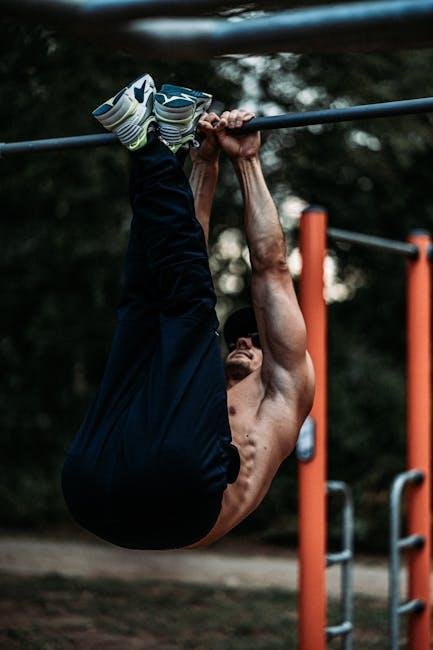Learning Your Frist Pull-Up: Progression Guide
In the world of fitness, the pull-up stands as a universal symbol of strength and a rite of passage for those eager to conquer the realm of bodyweight exercises. Whether you envision yourself effortlessly rising above the bar or are simply looking to break the chains of inertia, mastering your first pull-up can be both a challenge and a source of immense satisfaction.This article serves as your step-by-step roadmap to navigating the path toward this remarkable feat.With a structured progression guide, we will explore essential techniques, targeted strength-building exercises, and key insights to help you not only achieve that coveted first pull-up but also embrace a journey of physical empowerment. Whether you’re a seasoned gym-goer or a curious newcomer, prepare to unveil the strength within and redefine your limits.
Understanding the Mechanics of a pull-Up
to grasp the intricacies of a pull-up, it’s crucial to understand the primary muscle groups involved and the mechanics of the movement. When you perform a pull-up, your latissimus dorsi, biceps, and rhomboids work in unison to lift your bodyweight. This compound exercise primarily triggers muscle growth and strength progress in your upper body. The pull-up starts with your arms extended, engaging your grip. As you begin the movement, focus on squeezing your shoulder blades together, which initiates the lift.Keep your core tight to maintain stability and prevent unnecessary swinging.
Proper form is essential not only for effectiveness but also to avoid injury. Here are some key tips to keep in mind:
- Keep your shoulders down to avoid straining your neck.
- Engage your core to support your spine throughout the movement.
- Control your descent to build strength in both the upward and downward phases.
Additionally, consider the following table that highlights common mistakes and their corrections:
| Common Mistake | Correction |
|---|---|
| Inadequate shoulder engagement | squeeze shoulder blades at the start of each pull-up |
| Excessive swinging | Focus on core stability and controlled movements |
| Not fully extending arms | Start from a complete hang for improved range of motion |

Setting Realistic Goals for Your Pull-Up Journey
Embarking on your pull-up journey is an exciting challenge, but setting realistic goals is crucial to maintaining motivation and ensuring steady progress. Understand that mastering your first pull-up is not just about brute strength; it’s a combination of technique, body awareness, and patience. Begin by assessing your current fitness level and recognizing where you stand in relation to this goal. Consider setting short-term milestones, such as increasing your grip strength or enhancing your pull-up support technique, as these can significantly contribute to your overall progress.
To effectively track your progress, you can implement a simple weekly log that records your achievements and setbacks. This approach will not only keep you accountable but will also provide valuable insights into what works best for you. Below is a sample table to help you visualize your weekly advancements:
| Week | goal | Achievement | Comments |
|---|---|---|---|
| 1 | Negatives | 5 reps | felt strong! |
| 2 | Assistive Pull-ups | 3 x 5 reps | Used bands. |
| 3 | Gripper Exercises | 10 reps | Improving grip! |
| 4 | Pull-Up Holds | 15 seconds | Building endurance. |
By breaking down the process into manageable chunks and celebrating small victories, you’ll cultivate a positive mindset that propels you towards achieving that elusive first pull-up. Remember, every individual’s journey is unique; focus on your path, adjust your goals as needed, and enjoy the process of betterment.

Essential Exercises to Build Pull-Up Strength
To embark on your journey to your first pull-up, it’s crucial to include foundational exercises that target the muscles involved in the movement. Bodyweight rows are a fantastic starting point, as they help develop the upper back and arm strength necessary for pull-ups. For those who may find pull-ups daunting, assisted pull-ups using bands or a pull-up machine can provide the necessary support while allowing you to build critical strength. Additionally, incorporating negative pull-ups, where you lower yourself slowly from the top position, can definitely help strengthen your muscle endurance and control.
Don’t underestimate the value of strengthening the core, as a stable midsection is key to successful pull-ups. Planks, hanging leg raises, and Russian twists are excellent exercises for this purpose. Consider integrating these moves into your routine several times a week, focusing on the following target muscles:
| Exercise | Target Muscles |
|---|---|
| Bodyweight Rows | Back, Biceps |
| Assisted Pull-ups | Back, Biceps, Shoulders |
| Negative Pull-Ups | Back, Biceps |
| Planks | Core |
| Hanging Leg Raises | Core, Hip Flexors |
| Russian Twists | Core, Obliques |
By methodically incorporating these exercises into your training regimen, you’ll be well on your way to building the strength required to conquer your first pull-up. remember to progressively challenge yourself as your strength improves, ensuring that you keep your workouts engaging and effective.

Nutritional Support for Optimal Muscle Growth
To achieve optimal muscle growth, focusing on your nutritional intake is just as crucial as your workout regimen. Providing your body with the right balance of macronutrients lays the groundwork for strength gains and recovery. Prioritize a diet rich in proteins, healthy fats, and complex carbohydrates to fuel your muscles effectively. Incorporate the following foods into your meals:
- Lean meats: chicken, turkey, or lean cuts of beef
- Fish: salmon and tuna for their omega-3 fatty acids
- Dairy: Greek yogurt or cottage cheese for additional protein
- Nuts and seeds: almonds, chia seeds, and flaxseeds
- Whole grains: quinoa, brown rice, and whole wheat bread
Moreover, timing your nutrient intake can enhance your muscle-building efforts. Consuming a balanced meal or snack containing both protein and carbohydrates within 30 minutes after your workout can maximize recovery and support muscle repair. Here’s a simple table of post-workout snacks that blend the perfect nutrients:
| Snack | Protein (g) | Carbs (g) |
|---|---|---|
| Greek Yogurt with Honey | 20 | 30 |
| Tuna on Whole Grain Crackers | 25 | 20 |
| Protein Smoothie with Banana | 30 | 40 |
To Conclude
As we wrap up our exploration of conquering your very first pull-up, remember that every great achievement starts with a single step—or in this case, a single pull. The journey to mastering the pull-up is not just about physical strength; it’s also a testament to your commitment and perseverance. Embrace the process, be patient with yourself, and celebrate the small victories along the way.Whether you’re swinging from a bar for the first time or working on improving your form, allow this guide to serve as your trusty companion. With consistent practice and a positive mindset, you’ll soon find yourself defying gravity and achieving more than you ever thought possible.
So, hang tight, stay motivated, and let the journey unfold. Your first pull-up awaits, and once you achieve it, you may just find that the sky’s the limit. Happy training!
